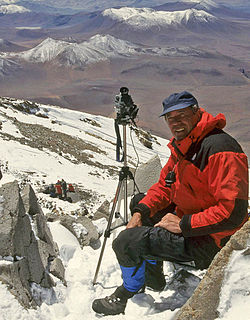Career
Born in Joliet, Illinois, Johan Reinhard lived in New Lenox, Illinois until 1962. He began his undergraduate studies at the University of Arizona, before going on to receive his Ph.D. in Anthropology from the University of Vienna, Austria (1974). Much his current research focuses on the sacred beliefs and cultural practices of mountain peoples and in the preservation of their cultural patrimony, especially in the Andes and the Himalayas. His anthropological field research since 1980 has primarily focused on the Incas and sacred landscape in Argentina, Bolivia, Chile, Ecuador, and Peru.
During 1989–1992 he directed an underwater archaeological research project in Lake Titicaca, the world’s highest navigable lake (12,500 ft), that resulted in the discovery of rare Inca and Tiahuanaco (pre-Inca) artifacts. He has lived more than ten years in the Himalayas, conducting anthropological research primarily in Nepal, [3] but he has also undertaken investigations in Tibet, Bhutan, Sikkim, and the Garhwal Himalaya. [3]
His studies in Nepal included culture change among the Raji of nomadic hunter-gatherers to settled agriculturalists; Himalayan shamanism; the role of sacred mountains in Tibetan Buddhism and Hinduism; the sacred "hidden lands" of Tibetan Buddhism (seven of which he has explored); and two of the world's last nomadic hunting and gathering tribes: the Raute and Kusunda. While in Nepal, he also directed Peace Corps Training Projects and was a member of teams that made some of the first rafting descents of Trisuli and Sun Kosi rivers. [3] Elsewhere in South Asia, in 1977 he studied Muslim fishermen in the Maldive Islands (Indian Ocean).
While living in Austria during 1972, he participated in an underwater archaeological study of a Neolithic site at Mondsee. In 1965 and 1967, he was also a member of teams which undertook nautical archaeological research of Roman shipwrecks in the Mediterranean Sea off southern Italy and of an Iron Age Villanovan village in a northern Italian lake (Lago di Bolsena) in 1965. His interest in the Iceman led to his study in recent years of the role of sacred landscape in Neolithic religion in the central Alps.
Johan first began mountain climbing in 1964 in the Alps and in the mid-1970s in the Himalayas, including participating on the successful 1976 American Everest Expedition and making a first ascent in 1979 of the South Face of Buni Zom (21,500 ft) in the Hindu Kush (Pakistan). His climbs in the Andes began in 1980 with ascents of mountains in Ecuador, and he eventually climbed the majority of Andean peaks over 6,500 m (21,325 feet)—several of them solo. A historian of Andean ascents for the American Alpine Club noted in the early 1990s that Johan had climbed more high-altitude Andean peaks (over 20,000 feet) than any other person.
While sky diving in the 1960s–1970s, Johan participated in 150 jumps in Europe and the US, including in snow, in water, at night, and in large free fall "stars," besides having made jumps with groups from over 20,000 feet in 1963— world records at the time. In 1979 he made one of the first crossings by a westerner of the Great Indian (Thar) Desert by camel, in 1980 one of the few land crossings of Tierra del Fuego in Chile, and in 1980 one of the few crossings of the Llanganatis mountain range in Ecuador to reach the Amazon.
Reinhard participated in underwater archaeological investigations of sacred lakes of the Incas, including in the crater lake of Licancabur in 1981–82 (the world's highest dive at 19,300 ft), and a lake at 19,100 ft on Paniri volcano in 1983. During 1987 and 2004, he dove in lower-lying lakes near Cuzco (including lakes Urcos, Huacarpay and Piuray), and in the highlands of Ecuador in 2009, while in 2007 and 2010 he was a member of teams that investigated sacred lakes of the Aztecs (13,800 ft) on Toluca volcano in Mexico and underwater archaeological sites in Lake Issyk Kul in Kyrgyzstan in 2010.
He has investigated traditional religious beliefs and climbed sacred mountains in Greece in 2002, in Bali, Indonesia during 2007, and in Venezuela, Mongolia, and the Holy Land (Israel) in 2012. He has served as a cinematographer for the BBC, the Smithsonian Institution, and the Scientific Film Institute of Germany, and his research has been featured in several TV documentaries, including National Geographic, BBC, NOVA, PBS, and Discovery. He is an avid photographer and his images have appeared in over a hundred newspapers, books and magazines, including National Geographic, Time, Newsweek, etc., and with thousands of these images available on his website.
He has lectured on cruise ships traveling in the Caribbean, along the Pacific coast of South America, and to Antarctica, the Galapagos, and Easter Island, and also lectured on round-the-world flights for the National Geographic Society. He speaks Spanish, Nepali, and German, and in Nepal he analyzed two unwritten languages: Raji, a Tibeto-Burman language, and Kusunda, a linguistic isolate.
